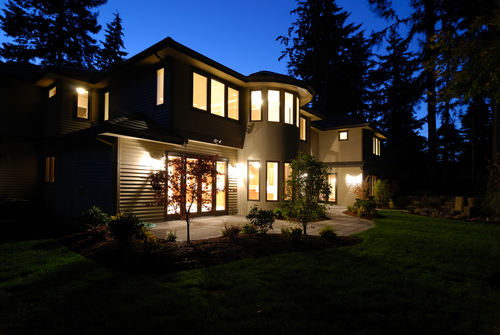Properly lighting your home, especially during the winter when it gets dark early, can have a strong effect on the morale of a household. While it may seem like a simple task at first glance, creating the proper ambience while still having enough light to see what you’re doing can provide a challenge.
There’s also the problem of energy usage to consider. Starting the process with an energy audit to make sure you are not spending too much money on your lighting is a good first step. Here are a few more considerations to keep in mind when lighting your home.

Lumens
When you are thinking about lighting any room, lumens will measure the brightness of the bulb you buy. They measure the light output directly; although the labels do not necessarily give recommendations as to how many lumens you need to fulfill your particular lighting needs. If the light bulbs are not labeled it is usually possible to calculate the lumens by converting the wattage of a bulb. The final result, of course, depends on the type of bulb. Modern-day LED light bulbs are very low wattage; a 1500 lumen bulb will only be about 25 watts. Which bulbs you choose will depend on the type of lighting you need.
Types of Lighting
There are three basic types of lighting that you need to consider when deciding how to light any room. Ambient light is also known as general light and is the light that fills the whole room. Ambient light can be provided by floor lamps, wall sconces, ceiling-mounted fixtures and any number of other light sources. Task lighting is targeted to a specific area in the room. For example, lights you have specifically placed on your kitchen counter so that you can better see the food you are preparing. Task lighting is provided by table lamps and lights that are built into cabinetry. Accent lighting is used to draw focus to a particular object such as a piece of art or a favorite plant. There are many ways to accent a certain object or area with light; small, adjustable light sources are usually the best choice.
Ambient Light
When considering ambient lighting, you need to think about the room’s specific needs and your personal preferences. To light a 250 square foot room, you’ll need a total of about 5,000 lumens. If you are using energy efficient LED bulbs that means you will need to make use of about five of them carefully placed throughout the room. The trick is to ensure there aren’t any dark spots in the room.
After installing the lamps and fixtures that you want to use, consider using recessed lights to cover up any areas that are not receiving proper illumination. When considering ambient lighting for a room, you should take your own needs and the needs of the other members of the household into account. If you are particularly sensitive to light, for example, consider installing a dimmer so that you can set the lights to the exact brightness that you prefer. If that’s not an option, choose bulbs with lower lumens. This ensures the entire room is lite to the brightness you prefer.
Task Lighting
Task lighting is usually reserved for working areas. Whether you are cooking, reading, or working on a project at home, you will need to provide enough light to successfully see what you are doing. The measurement of task lighting is usually about 50 lumens per square foot, which means you can make use of smaller light bulbs. The obvious choice for providing task lighting are portable desktop lamps that can easily be moved anywhere you require a little bit of extra light. An average desktop lamp will put out about 200 lumens. This can easily light a small area like a desk without bringing too much light to the surrounding areas.
Installing lights under cabinets is also a great way to illuminate your kitchen, making it easy to see what you’re doing when you are hard at work preparing a meal for your friends or family. Mounted lights can also illuminate the dinner table itself when it comes time to serve the meal you’ve worked so hard on.
The goal with task lighting is to avoid dark spots and harsh shadows in your home. Not only will this improve the mood of an area, it will also provide a functional way to see everything that you are doing while at work.
Accent Lighting
Accent lighting should only be considered when you have already taken care of your ambient lighting and task lighting. Small bulbs that give out only a small number of lumens are best use as accents. Commonly, string lights, tape lights, and other tiny bulbs are great for accent lighting and also add to the atmosphere of a room.
Accent lighting is also used to illuminate specific objects such as a piece of art like a painting or sculpture. You have a lot of options when installing accent lighting in your home, but don’t forget to incorporate this more aesthetic lighting last.
Layering Lights
The trick to a perfectly lit room is to layer the lights. Properly layered lighting will reduce the shadows and dark areas of a room while also providing a sense of depth, making the room appear more inviting. Keeping the ambient lighting at a lower level than the task and accent lighting will help to bring attention to your favorite areas of a room while providing a pleasant mood. To help calculate your specific needs, consider the size of a room. One light per four square feet is usually a good choice when it comes to ambient lighting.
Again, it is recommended you have an energy audit of your home performed. This will help you discover how to maximize the energy efficiency in your home. If you choose a company like Entek, they will also provide you with general electrical services including an inspection of your outlets and other power sources. They will help you replace old, outdated lighting fixtures with more modern, energy efficient ones that also help you find the exact mood that you want.
An energy audit can also ensure that the light switches are in the most efficient places. Light switches should be easy to reach and low enough that they will not interfere with other fixtures on the walls such as artwork. Often, it’s simple changes like the types of bulbs you use that can save you thousands of dollars over the years.
Modern lights, with features such as LED bulbs, are vastly more energy efficient than the incandescent bulbs of the past. Of course, you will also want to consider how bright you want your space to be. Bulbs with higher lumens will be more luminous, but will also consume more energy.



